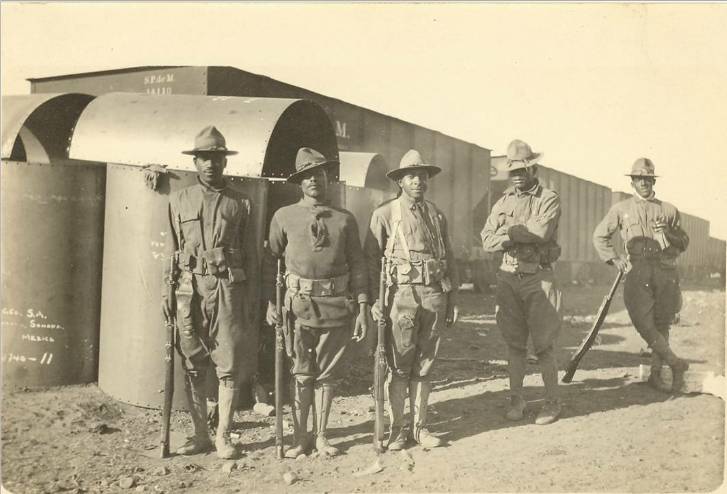|
| Buffalo Soldiers at Naco, Az. 1914 |

|
| From collection of Garrick Bailey University Tulsa |
To see more pictures click here or click on Fort Naco above
BUFFALO SOLDIERS
African-Americans have fought with
distinction in all of this country's military engagements. However, some of their most notable contributions and sacrifices
came during the Civil War. During that conflict, more than 180,000 African-Americans wore the Union Army blue. Another 30,000
served in the Navy, and 200,000 served as workers on labor, engineering, hospital and other military support projects. More
than 33,000 of these soldiers gave their lives for the sake of freedom and their country. 23 African-Americans received the
nation's highest military award during the Civil War.
On July 28, 1866, Congress established a peacetime army, drastically reducing
the size of the force, and abolishing all the African-American units created during the Civil War. Four new cavalry regiments
were created. Two were composed of colored men. Four new "colored" infantry units were also created. The six new black
units were the 9th and 10th Cavalry and the 38th, 39th, 40th and 41st Infantry. The four black regiments, two infantry and
two cavalry, remained in the West until the Spanish-American War. During this period, the U.S. Army consisted of just
10 cavalry and 25 infantry regiments, meaning that one in five cavalry soldiers and one in eight infantry soldiers were black. Nicknamed Buffalo Soldiers supposedly by the Indians because of the similarity between their hair and the coat of
the buffalo, many soldiers of the black regiments were recruited from the United States Colored Troops, which served in the
Civil War. Other enlistees came from the New Orleans area, the fringes of the southern states and from large northern
cities. The Buffalo Soldiers, comprised of former slaves, freemen
and Black Civil War soldiers, were the first to serve during peacetime.
Buffalo Soldiers were responsible for
escorting settlers, cattle herds, and railroad crews. They also conducted campaigns against American Indian tribes on a western
frontier that extended from Montana in the Northwest to Texas, New Mexico, and Arizona in the Southwest. Throughout the era
of the Indian Wars, approximately twenty percent of the U.S. Cavalry troopers were Black, and they fought over 177 engagements.
Buffalo Soldiers participated in many other military campaigns: The Spanish American War, The Philippine Insurrection, The
Mexican Expedition, World War I, World War II, and the Korean Police Action. The 9th and 10th Cavalries' service in subduing
Mexican revolutionaries, hostile Native Americans, outlaws, comancheros, and rustlers was as invaluable as it was unrecognized. It was also accomplished over
some of the most rugged and inhospitable country in North America. A list of their adversaries included Geronimo, Sitting
Bull, Victorio, Lone Wolf, Billy the Kid, and Pancho Villa - reads like a "Who's Who" of the American West.
Lesser known, but equally important, the Buffalo Soldiers explored and mapped vast areas
of the southwest and strung hundreds of miles of telegraph lines. They built and repaired frontier outposts around which future
towns and cities sprang to life. The Buffalo Soldiers consistently received some of the worst assignments the Army had to
offer. They also faced fierce prejudice to both the colors of their Union uniforms and their skin by many of the citizens
of the post-war frontier towns. Despite this, the Buffalo Soldiers developed into the most distinguished fighting units in
the Army.
The buffalo soldiers: Who they were and their contributions to military history
Buffalo Soldiers at Fort Huachuca
HenryO.Flipper 1
Col. Charles Young 1
Col. Charles Young 2
Col. Allen Allensworth
Female Buffalo Soldier-Cathay Williams or William Cathay
Buffalo Soldiers at Huachuca The Battle of Naco
Sergeant Henry Parker
Sancho Mazique, A Buffalo Soldier Remembered
SEMINOLE-NEGRO INDIAN SCOUTS
Buffalo Soldiers
John Horse
The Forgotten Black History of How Memorial Day Started | TIME
Click here to see our other web site
|



